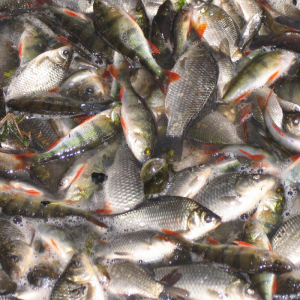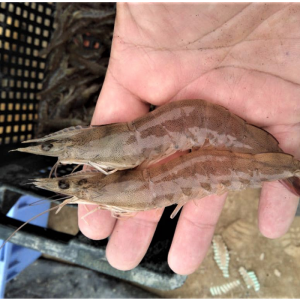
Polyculture Of Pikeperch Juveniles in Recirculating Aquaculture Systems
| Thu, 25 Feb 2021 - 12:10
Recirculating aquaculture systems (RAS) are mainly used to intensively produce a single species (monoculture), and predominantly fish species that have high commercial value such as Atlantic salmon, flatfishes and others. RAS technology has many well-known advantages, including reduced water use, minimal footprint, greater control, high production and limited environmental impacts, among others. Also, RAS operations can be very restrictive for fish that are subject to stress through handling, containment and high-density conditions.
Although monoculture is the predominant approach in RAS, polyculture (production of more than one species) could theoretically overcome some of the limitations of this production system. Polyculture has been proved to be a valuable option to increase the efficiency and the sustainability of production systems. Polyculture can improve the system operation by taking advantage of coexistence and interactions between different species, supporting better feed resource utilization and limiting feed losses, less waste through recycling and optimal utilization of culture space.
Very few studies have evaluated polyculture implementation in RAS operations. To help generate pertinent information, we carried out the first multi-trait assessment of RAS polyculture of several fish species, comparing survival rates, growth performance and behavior of pikeperch (Sander lucioperca), a freshwater carnivorous species in monoculture or in polyculture with two other species – sterlet (Acipenser ruthenus) and tench (Tinca tinca). We chose these species because their polyculture could improve pikeperch RAS productions.
Also read: Benefits of Recirculating Aquaculture Systems
Pikeperch is a valuable freshwater mainly produced in RAS monoculture. This production strategy faces two main challenges: steady supply of good-quality water and fish stress reduction. As pikeperch does not take the feed on the bottom of the production tanks, its monoculture impacts water quality. Therefore, associating pikeperch with bottom-feeder species such as sterlet and tench could improve the water quality and therefore the fish production.
Moreover, pikeperch is very sensitive to stress in rearing systems. Although no scientific assessment is available to date, fish farmers commonly add tench during transportation of other fish species because of their known calming effect on other fish. Therefore, co-rearing of tench and pikeperch could mitigate the pikeperch stress issue. Although pikeperch and sterlet co-rearing in RAS has already been investigated by other researchers, its production potential and any behavioral issues are not documented.
This article – adapted and summarized from the original publication (Thomas, M. 2020. The effects of polyculture on behavior and production of pikeperch in recirculation systems. Aquaculture Reports Vol. 17, July 2020, 100333) – compared survival rates and growth and behavior of pikeperch reared alone and with other fish species in a RAS system.
Study setup
The experiment was carried out at the Experimental Platform for Aquaculture of the UR AFPA lab, Faculty of Sciences and Technologies, University of Lorraine (France). Juvenile pikeperch (58 ± 10 grams) were reared in our facilities, whereas juvenile sterlet (17 ± 4 grams) and tench (40 ± 6 grams) were obtained from the Fisheries Cooperative Györ (Hungary).
Before the beginning of the experiment, fish were transferred into indoor aquaria, each an independent RAS. Water quality parameters were maintained within acceptable levels and controlled during the acclimation and experimental periods. Fish were fed manually with a commercial diet and aquaria were cleaned once a week. Rearing conditions followed established fish farmer practices and scientific literature.
Four treatments – pikeperch monoculture (P); pikeperch and sterlet polyculture (PS); pikeperch and tench (PT); and pikeperch, sterlet and tench (PST) – were tested, each in triplicates (Fig. 1). The total initial biomass differed between aquaria, but we chose to work with a fixed number of fish per aquarium instead of uniform biomass because the number of fish could influence their behavior, and particularly their relationships. Fish growth and survival data were collected and analyzed.

Fig. 1: Description of the experimental design. Four treatments were tested in triplicate: one treatment in monoculture: P (pikeperch) and three treatments in polyculture: PS (pikeperch and sterlet), PT (pikeperch and tench) and PST (pikeperch, sterlet and tench). The initial fish number was 36 (with an adjustment of fish number by species according to the treatment).
For detailed information on the experimental design and environment; production parameters; behavioral assessments, interindividual interactions and group structures; and statistical analyses, refer to the original publication.
Also read: Feeding Systems for Fish Farms and RAS
Results and discussion
The survival rate for pikeperch in our study was 100 percent after one month in all experimental treatments. At the beginning of the experiment, pikeperch weights were similar between the four treatments, but the mean final weights between the four treatments were significantly different. Pikeperch alone had lower weight than those pikeperch with tench, and those with both tench and sterlet (treatment P: 75.7 ± 2.7 grams; treatment PT: 85.7 ± 8.1 grams; treatment PST: 90.3 ± 1 6.4 grams). Moreover, the weight of juvenile pikeperch was lower when fish were reared with sterlet than for pikeperch reared with both tench and sterlet (PS: 80.1 ± 3.2 grams).
After one month, there was no difference in the coefficient of variation, CV [a measure of uniformity of size distributions] between the pikeperch in the four treatments. Pikeperch biomass gain (BG) also differed between the four treatments after one month. The pikeperch alone had lower BG than those pikeperch reared with tench and those reared with both sterlet and tench (P: 25.2 percent; PS: 38.3 percent; PT: 50.1 percent; PST: 51.5 percent).
Our results show that RAS polyculture of pikeperch positively affects juvenile fish rearing performance without significantly affecting their behavior. Indeed, although the number of contacts between pikeperch juveniles was lower under monoculture than under polyculture conditions, we detected no aggressive behavior between conspecifics [of the same species].
We observed an increase in pikeperch weight from 25 percent in monoculture to 51 percent in polyculture. The better growth rate measured in our study could result from using different pikeperch individual densities between the four treatments. In contrast, pikeperch individual densities were similar in monoculture and polyculture treatments in a previous study by other researchers, because density can change feed availability and/or intraspecific relationships for individual pikeperch.
Pikeperch consumed feed mostly in the water column, with a very low percentage of the pellets eaten at the bottom. Therefore, even though feed quantities were lower when pikeperch juveniles were associated with the other species due to the lower biomass of these species, pikeperch benefited from the total feed amounts for all the species while feed was in the water column. This meant that there could have been less competition between pikeperch, as they had larger amounts of food per individual and consumed the feed before the other two species. This was also supported by the results from the behavioral analysis, which revealed lower cohesion and homogeneity of the pikeperch group when they were reared alone compared to the polyculture treatments.
Also read: A successful Case of Split Pond Recirculation Aquaculture System (SP-RAS) for Snakehead Fish Farming in Andhra Pradesh of India
Intraspecific competition is a known key characteristic of the social life in pikeperch, and generally leads to the establishment of hierarchy with dominant fish. Since this social relationship depends on the fish density (i.e., dominance increases at higher density), the loss of feed due to intraspecific competition and subsequent lower growth is more likely in the pikeperch alone treatment.
Additional attention should be given to the limits of our experiment before projecting our results to an economic scale. We used low fish densities (∼7 kg per cubic meter in the treatment pikeperch alone and lower in the treatments with the other two species), which is quite lower from the RAS pikeperch monoculture industry conditions (i.e. 80 to 100 kg per cubic meter). Since the fish density could directly influence the growth through the interindividual competition for food, our results could not be transposable to industrial fish farming contexts. And our trial lasted only 30 days, while the rearing period of juveniles is one year in the pikeperch industry. However, the growth parameters we measured in our study can be projected over the entire juvenile growing period since juvenile growth is a continued function during this early life stage.
Our results suggest that the implementation of polyculture in RAS could be an interesting option for the rearing of juvenile pikeperch. In general, we believe our results should be considered as a first step, showing the feasibility and the potential of RAS polyculture for fish production. It opens up great prospects for future studies on RAS polyculture with conditions closer to commercial scale aquaculture, in order to provide a comprehensive assessment of the potential of polyculture in intensive indoor fish farming.
Perspectives
Our results show the positive effects on growth and only a few behavioral changes in pikeperch, indicating that RAS polyculture is a relevant alternative option for the rearing of juvenile pikeperch compared to monoculture. Our research opens up new prospects for the production of high-value species such as pikeperch and support the need to move towards more efficient and sustainable aquafarming systems.
Source: Global Aquaculture Alliance






















